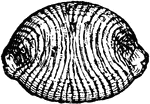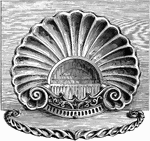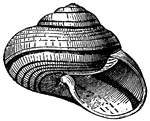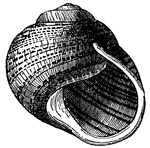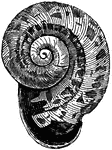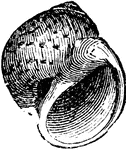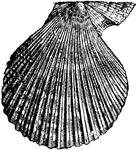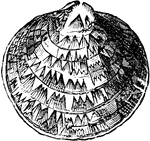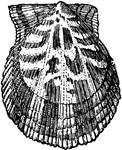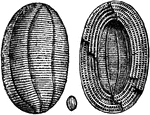
Alveolina Ovoidea (d'Orbigny)
"The Foraminifera are enclosed in minute calcareous shells, early invisible to the naked eye; they are…

Letter A with Angels
This letter A with angels is designed with the angels playing a trumpet and a sea shell in the background.…
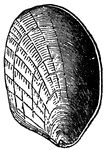
Aplysia Depilans (Linn.)
"The Molluscous Gasteropoda have the organs of respiration formed for aerial respiration or for respiration…

Aplysia Inca (D'Orbigny)
"The Molluscous Gasteropoda have the organs of respiration formed for aerial respiration or for respiration…
Aspergillum Vaginiferum (Lamarck)
It has received the strange name of the Watering-pot because of a convex disk that is pierced with holes…
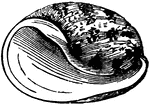
Bulla Ampulla (Linnaeus)
"The animals have a well-developed shell, the form of which is elegant and delicate in structure. They…
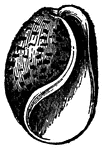
Bulla Aspersa (Adams)
"The animals have a well-developed shell, the form of which is elegant and delicate in structure. They…

Bulla Oblonga (Adams)
"The animals have a well-developed shell, the form of which is elegant and delicate in structure. They…

Calcarina Calcitrpoides (Lamarck)
"The Foraminifera are enclosed in minute calcareous shells, early invisible to the naked eye; they are…
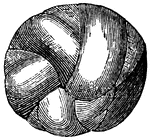
Cassidulina Laevigata
One group will take the spherical form and produce a shell in the shape of the nautilus. In this case,…

Conus Gloria Maris (Chemn.)
"The genus Conus is especially rich in species, as well as numerous individuals. This group…

Conus Nobilis (Linn.)
"The genus Conus is especially rich in species, as well as numerous individuals. This group…

Conus Tescallatus (Born.)
"The genus Conus is especially rich in species, as well as numerous individuals. This group…

Conus Textilis (Linn.)
"The genus Conus is especially rich in species, as well as numerous individuals. This group…
Dentalina Subarcuata
"The shell advances beyond this simple type by a process of linear budding, the first cell being spherical,…

Fabularia Discolithus (Defrance)
"The Foraminifera are enclosed in minute calcareous shells, early invisible to the naked eye; they are…

Haliomma Hexacanthum
The body is enclosed in a glassy shell composed of flint. The shell is perforated by numerous holes…
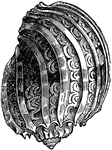
Harpa Ventricosa (Linnaeus)
"The genus Harpa contains shells from the Indian ocean, richly enameled within and ornamented…

Helix Aspersa (Var. Scalaris)
"The snails are male and female in the same individual, or hermaphrodite. The Romans had many species…
!["The snails are male and female in the same individual, or hermaphrodite. [This is] the favorite culinary snail in the region around Paris"](https://etc.usf.edu/clipart/51300/51387/51387_helix_pomati_mth.gif)
Helix Pomatia (Linnaeus)
"The snails are male and female in the same individual, or hermaphrodite. [This is] the favorite culinary…
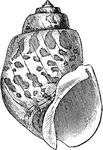
Ivory Shell
The Ivory Shell (Eburna spirata) is a gastropod mollusk in the Buccinidae family of true whelks.

Limnaea Stagnalis (Linnaeus)
A thin diaphanous shell in which species of the genus Limnaea live. They can be found in the fresh waters…
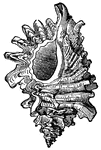
Murex Erinaceus (Linnaeus)
"The genus Murex, or Rock Shells, includes a large number of species, all remarkable for their…

Murex Haustellum (Linnaeus)
"The genus Murex, or Rock Shells, includes a large number of species, all remarkable for their…

Murex Scorpio (Linnaeus)
"The genus Murex, or Rock Shells, includes a large number of species, all remarkable for their…

Murex Tenuispina (Lamarck)
"The genus Murex, or Rock Shells, includes a large number of species, all remarkable for their…
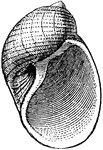
Naticoid
Naticina papilla is a species of naticoid, a predatory sea snail in the gastropod class of Mollusca.

Naticoid
Naticina haliotoides is a species of naticoid, a predatory sea snail in the gastropod class of Mollusca.
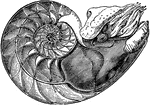
Nautilus Pompilius (Linnaeus), showing the interior of the lower cell, to which the animal is fixed.
"In the last partition of the shell is the animal, covered by its mantle, which lines to walls of the…
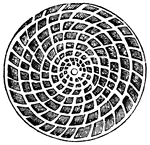
Nummulina Perforta
One group will take the spherical form and produce a shell in the shape of the nautilus. In this case,…
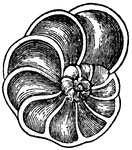
Operculina
One group will take the spherical form and produce a shell in the shape of the nautilus. In this case,…
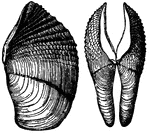
Pholas Crispata (Linnaeus)
This species is able to hollow out a home in a solid block of gneiss, one of the hardest rocks. To excavate…
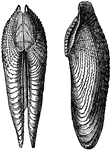
Pholas Dactylus (Linnaeus)
This species is able to hollow out a home in a solid block of gneiss, one of the hardest rocks. To excavate…
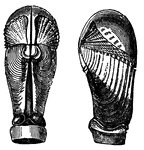
Pholas Melanoura (Sowerby)
This species is able to hollow out a home in a solid block of gneiss, one of the hardest rocks. To excavate…

Pholas Papyracea (Solander)
This species is able to hollow out a home in a solid block of gneiss, one of the hardest rocks. To excavate…
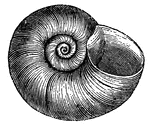
Planorbis Corneus (Linnaeus)
The shell of the Planorbis is thin, light and disk-like in form. The can creep along solid bodies, or…
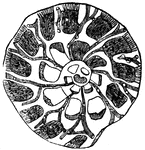
Rotalia
One group will take the spherical form and produce a shell in the shape of the nautilus. Some are more…
